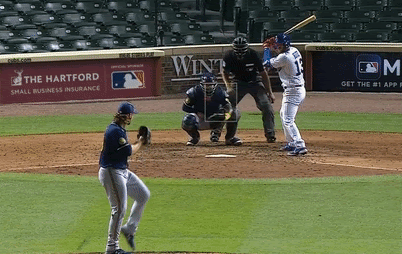A look at Josh Hader and his ultimate rival, as well as our favorite Brewers and Twins small sample size stats
The Twins pitching staff is the third-best in baseball history at one particular stat through nearly four weeks
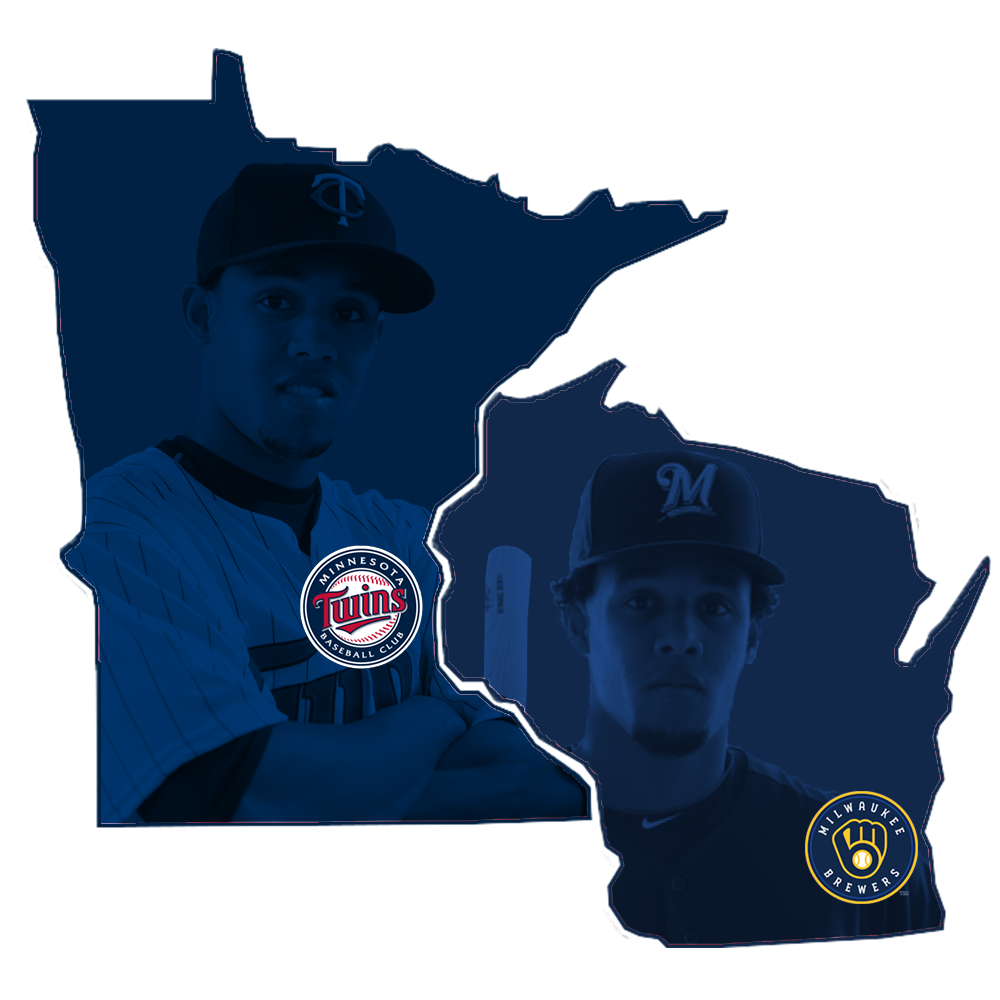
Rich People Conversations is (we think) the world’s only Brewers-and-Twins newsletter. Written by three friends who spend far too much time watching MLB.tv, it takes a look at the quirky side of baseball while also delivering plenty of analysis and #takes. You can subscribe—for free—below.
Josh Hader vs. Anthony Rizzo has become must-see TV
~Curt
When it comes to which team is the Brewers’ biggest rival, the answer is probably the Chicago Cubs, although the St. Louis Cardinals could have a say in the subject matter. This isn’t groundbreaking stuff.
But which hitter-pitcher matchup involving a Brewer is the best rivalry?
After yet another matchup in a high-pressure moment over the weekend, may I submit for discussion Josh Hader vs. Anthony Rizzo?
Hader’s call-up to the majors in 2017 was right around the time when the I-94 rivals started playing a slew of meaningful, competitive games.
Hader first faced Rizzo in his 14th big league appearance, a memorable three-inning, six-strikeout outing; they have done battle 13 times since.
The 14 plate appearances by Rizzo are the second-most of any opponent against Hader in his career, trailing only Eugenio Suarez’s 15. The Cubs first baseman is just 2-for-11, but one of those hits was a homer and he’s walked three times to earn a .812 OPS.
Some of those at-bats have been memorable battles. Let’s revisit what makes Hader-Rizzo so compelling.
The Labor Day Longball
Hader struck Rizzo out in that first meeting in July of 2017. Later that season, during a tense September affair (that was decided by a 10th-inning homer by Kris Bryant; Jake and I were working together in Minnesota that night and I think he may have thought I wasn’t coming back from that one) in which Hader threw another three scoreless frames, Rizzo reached on an infield hit.
Hader didn’t face Rizzo again until June of 2018, when they faced off twice in three days.
In the first plate appearance, Rizzo walked, but only after sending a ball about 450 feet foul. Had he hit it 10 feet to the left, it would’ve been a tiebreaking dong in the eighth.

See that little white dot above the pole? That is Anthony Rizzo’s work.
Two days later, Rizzo struck out. He was not happy with the call.

Paint.

Upset Anthony.
It was on Labor Day of that season, though, when Hader-Rizzo turned from a couple of dudes who are good at baseball squaring off to OH, THIS IS GONNA BE GOOD.
Milwaukee began that day four games back of the first-place Cubs. Leading, 2-1, the Brewers sent Hader out to begin the sixth. He retired Rizzo on a liner to begin that frame. The score remained the same until Rizzo came up again in with two away in the eighth and a runner on second.
Rizzo then turned on a fastball and gave the Cubs a lead.

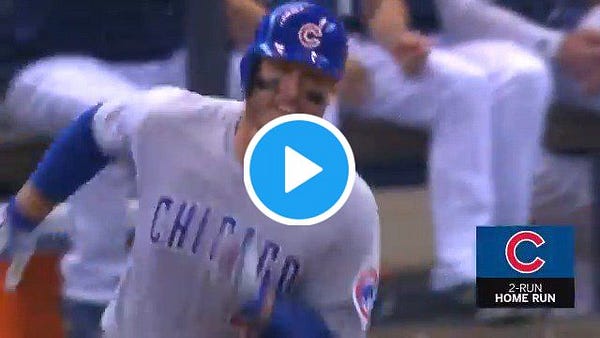
Now—and this will become a trend—the Brewers still won despite Rizzo getting the best of Hader.
September 2018 didn’t end there
So Rizzo had just taken his long-haired foe deep, becoming the first lefty to do so at any professional level since 2015.
Just one week later as the teams continued to play high-intensity games that went down to the wire, the Brewers traveled to Wrigley. Sure enough, Hader was summoned to protect a 3-2 lead in the 7th. As part of a memorable outing in which he struck out all six batters he faced in a Milwaukee win, Hader faced Rizzo and, well, I guess I already spoiled the outcome in this very sentencce.
Two nights later, again protecting a one-run lead, Hader fanned Rizzo in the eighth. He did so on a 98 mph heater, one of his hardest fastballs of the season. The Brewers won that game, as well, to pull within one game behind in the standings.
Game 163
With the NL Central title on the line, Javier Baez’s single with two outs in the bottom of the ninth kept the Cubs alive. They trailed, 3-1, which meant that the tying run was coming to the plate.
Only fittingly, Hader was the Brewers pitcher. And, of course, Rizzo was the one strolling to the dish.
It’s like the baseball gods manufacture the drama in Hollywood during the off-season sometimes.
The first pitch was a fastball outside. Ball one. Rizzo saw it all the way in. The ESPN broadcast panned to the Brewers bullpen, which featured Brandon Woodruff warming as Hader went over 30 pitches on the day. This is something I have no recollection of but, lol were we one batter away from getting Brandon Woodruff’s first moment as a big league closer in a Game 163 tiebreaker???
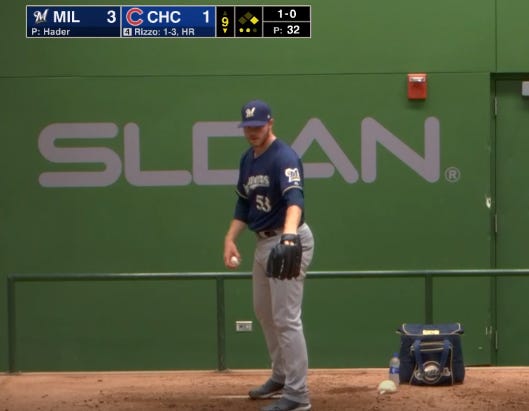
The next pitch was another fastball. It caught a lot of the plate, but it snuck up on Rizzo, as Hader fastballs are prone to do, and he fouled it off to the left.
Hader came back with another fastball, this one just below the knees. Rizzo had committed to swing and by the time he realized it was two inches low, it was too late. Strike two.
Then came another fastball. The Brewers won the division. You may recall this.
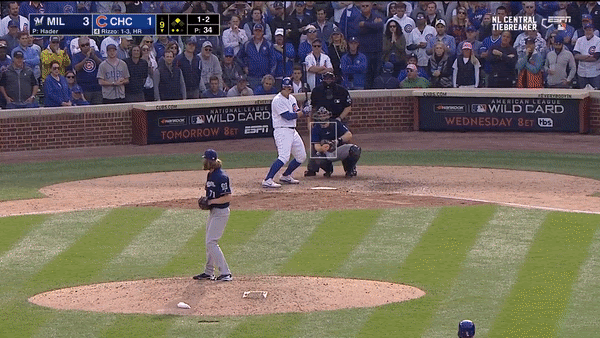
But wait, there’s more!
Of course, that wasn’t the end of the Hader-Rizzo Showdown Series.
A summary of the five matchups which, once again, were all in some pretty big spots.
April 7, 2019: Brewers leading, 4-2, with Cubs runners on the corners and two outs in the seventh. Hader struck out Rizzo swinging to end an eight-pitch battle. Milwaukee wins, 4-2.
July 26, 2019: Brewers leading, 3-2, with one out in the ninth and Rizzo up as the go-ahead run. Hader gets Rizzo out in front on a slider and he serves it right to Tyler Saladino. Milwaukee wins, 3-2.
August 31, 2019: Brewers leading, 2-0, in the eighth. Rizzo hits a screamer back up the middle, but Orlando Arcia is there to make a sprawling grab for the second out of the inning. Milwaukee wins, 2-0.
September 7, 2019: Hader inherits a mess. The Cubs have loaded the bases with nobody out against Junior Guerra in a 1-1 tie in the top of the eighth. Hader enters and strikes out Nick Castellanos, but loses his command and walks Rizzo on five pitches to bring in the go-ahead run, and Rizzo is very animated on his way to first base. Milwaukee gets the last laugh, though, as Hader allows no further damage, Yasmani Grandal ties it in the bottom half and Christian Yelich wins it in the ninth with a walk-off double.
August 14, 2020: Just this past weekend, the Brewers led, 4-3, in the bottom of the ninth at Wrigley. Hader retired the first two batters he faced with relative ease before walking Rizzo on five pitches yet again. On the 3-0 pitch, Rizzo got a fastball on the inside corner and tried to send it out in almost the same scenario as his long foul ball in 2018. This time, though, he swung through it. Hader would strike out Baez one batter later to end the game.
Fun with small sample sizes
We’re far enough into the season where most players’ sample sizes aren’t so small that they’re going to lead to absolute wonky statlines, but we’re also not far enough out where there isn’t going to be some small-sample craziness. These are our favorite SSS goodies thus far.
Twins
~Jake
Eddie Rosario and his unbelievable 9.6% walk rate
Walk rates almost never change year-to-year. Sure, maybe a percentage point or so, but very few guys ever make drastic changes in this category. You have a good eye or you don’t. Eddie Rosario is breaking that trend a bit.
If you’ve watched Rosario at all over the years, you know the guy hates free passes and swings at everything. He still swings at a lot, but he’s upped his walk rate from 3.7% last year (4.5% for his career) to 9.6% this year. That’s just a smidge over league average (9.1%) but could make a big difference if the change is real.
His patience is paying off. Though his batting average is down (.213 so far), he’s hitting for more power, posting a career-high .280 ISO (isolated power). He’s been unlucky, hitting just .175 on balls in play, which is way down compared to his career .306 mark. That should stabilize over the next 40 or so games, and if he can pair that with a more selective eye, we could see an unleashed, powerful Rosario.
Miguel Sano strikes out 47.7% of the time
If you’ve watched the big fella this summer, that number might even feel a bit low. Sano has been a true feast or famine guy this year, hitting four homers and walking 12.3 percent of the time, but striking out in seemingly every other plate appearance. In baseball terms, Sano is nearing complete Three True Outcomes territory.
[Professor Jake has arrived]
Don’t know what Three True Outcomes (TTO) are? Here goes: In baseball, there are dozens of potential outcomes. So many of these outcomes, though, are technically determined by the fielders. If you think about it, a player gets a single only because the centerfielder fields the ball hit to them and throws it back into the field, right? That’s the only thing stopping the batter from going around and touching every base.
So, what if you just remove all of those instances? Take away the fielders and take away all of the balls put in play. If you just focus on the interplay between pitcher and batter, there are really only three things that can happen: a walk, a strikeout or a home run.
With that in mind, let’s look back at Miguel Sano. In 2020, he’s striking out 47.7% of the time, walking 12.3% of the time and homering 6.2% of the time. That means 66.2% of his plate appearances end in one of the three true outcomes, taking the game completely out of the fielders hands in two-thirds of his at-bats.
Sano has always been a big strikeout guy (36.6% for his career), but 47.7% is untenable. It’s the highest in the league for any player with more than 30 plate appearances. In fact, it would go down as the highest percentage in baseball history, if it continued and this season wasn’t super weird.
Twins pitchers leaving stranding 81% of baserunners
Think of the best pitching staffs you’ve ever seen. Got it?
They never stranded a higher percentage of baserunners than the Minnesota Twins this year.
The Twins staff has an 81% left-on-base percentage (LOB), which would be the highest of all time if it wasn’t for the Cleveland baseball team and the Dodgers sporting 83.6% and 81.8%, respectively.
You could argue and say it’s clutch pitching or the staff is just crazy talented. It’s unlikely they’re the best ever, though.
LOB% is not normally a strong indicator of talent because of something called cluster luck. Let’s say a pitcher allowed four hits over the course of seven innings. Is that good or bad? Well, it depends on when those hits came, and the kind of hit, right? If you give up four hits scattered throughout the seven innings, the pitcher probably had a great day. If they were back-to-back-to-back-to-back, though, probably not so much. How much control did the pitcher have over that, though? There’s certainly some skill involved in not accidentally teeing the ball up four times in a row. It’s also a fair deal of luck. In past years, about 70% of balls put in play have gone for an out. The pitcher can’t control if that ball goes for a single past a diving shortstop or if it’s three inches to the left and an easy double play.
So, LOB% is stat that is somewhat indicative of what happened over the course of the game or series, but it’s not a terribly predictive stat. While the better pitching teams tend to strand more runners, this is more often associated with high strikeout rates. You’re less likely to strand a runner if you’re a contact-oriented pitching staff just because balls bounce and do funny things, and sacrifice flies still score runs, even if you get the out.
OK, so what does that mean? Basically, this is good news! It shows that the Twins have been good at buckling down and stranding runners. They aren’t going to set a record, but if they even stay in the vicinity of 81%, that could save a lot of runs.
Brewers
~Curt
Manny Pina leading all Brewers position players in WAR.
Pina has been worth 0.6 WAR according to both FanGraphs and Baseball Reference. He’s been a plus behind the plate, as expected, but he’s also been the team’s best and most consistent hitter. He’s squaring the ball up, chasing less and providing some pop.
Josh Lindblom pairing a 35.9 K% with a 67% LOB%.
Okay, this one’s a bit nerdy, but Jake already went over how LOB% works and what it can mean; it’s largely luck-driven. The one counter to banking on lady luck with runners in scoring position, though, is not allowing the ball to get put into play. (This is why Josh Hader has such high LOB numbers). This year, league average LOB% this year is 71.7%, so the fact that an above-average number of runners that reach base are scoring against Lindblom despite him striking out a ridiculously large amount of hitters is crazy and will soon even out in his favor.
Josh Hader hasn’t given up a hit yet.
Oh, man, has this been some serious Ball Don’t Lie from Hader’s homer rampage in 2019. It ain’t gonna last at this level, but the more important thing for Hader anyway is keeping the ball in the yard since he strands walks and singles at such a high clip.
Four Brewers relievers have a K% over 40%
Three relievers had a 40% K% last year. In all of baseball. Hader (6.1 IP), David Phelps (8.2), Devin Williams (8.2) and Fred Peralta (12) are all over 40% at the moment, which is hilariously insane.
Alex Claudio has more saves than Craig Kimbrel
Whatever you do, do not show this stat to Theo Epstein.
Orlando Arcia’s 10.2 K%
A guy with a career 20.2 K% is in the 97th percentile for avoiding strikeouts among all players with at least 40 PA. That’s wild. (Don’t ask about Ben Gamel. Or Keston Hiura. Or Miguel Sano. Oh wait Jake already tattled on Sano’s K%)
Here, watch some filth
~Curt
It is that time of the newsletter, folks. Put the kids to bed and grab a clothespin to put over your nose. It’s about to get nasty.
Jake and I were having a brief discussion the other day about who has the prettiest swing in baseball. I tossed out Ed Rosario as a candidate; he’s got a really pretty swing. Well, not on this Josh Hader slider to seal the Brewers’ lone win over the Twins.

I have a take that I would like to get out there. Devin Williams’ changeup is the nastiest pitch in the Milwaukee bullpen. I already feel better now.

You know, now that I think of it, maybe praising Ed Rosario’s swing just a little bit ago wasn’t a fantastic idea by this point. Alas, I guess we could just put any of his three dingers at Miller Park here to counter some of these ugly swings.
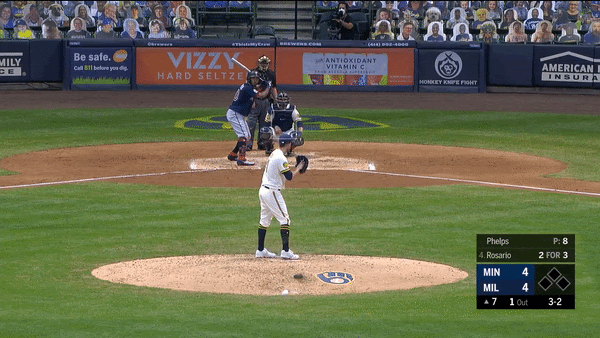
Now for some Twins nastiness.
This can be reported as bullying in 48 of 50 states. And also Guam.
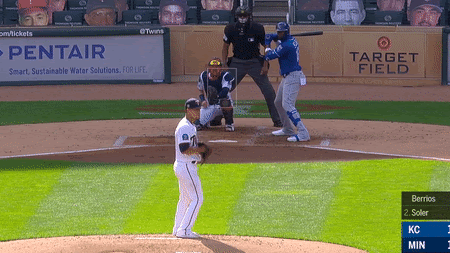
Cody Stashak looked really, really good against the Brewers on Tuesday. Also, Tom jinxed Ben Gamel.

Kenta Maeda also threw a changeup that I had to watch five times before I actually believed it was a changeup and not a curve.

Would you like to see literal perfect placement for a 96 mph heater? Trevor May has entered the chat.

I know that Christian Yelich’s go-ahead three-run homer was what lifted the Brewers to victory on Friday at Wrigley, but Freddy Peralta’s work in the fifth was the biggest key. He inherited a 3-1 deficit with the bases juiced, one out and Javy Baez due up. Then he did this (before striking out the next guy, too).

Sergio Romo looks beautiful in those baby blues, and a wiffle ball slider is a very nice accessory.

This wasn’t quite Brandon Woodruff’s hardest-thrown fastball of the year, but, at 99 and right on the corner, it was maybe his best.

You’ll see Marwin Gonzalez slide his left foot back, as if the ball was about to hit him. That’s because Josh Lindblom’s curveball was a) about to hit him. b) still painted for a strike.

And, look, another Lindblom curve!

Lol, you didn’t think I was gonna get through an entire one of these segments without putting Corbin Burnes in here, did you?
